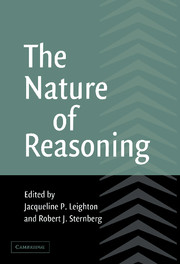Book contents
2 - Reasoning and Brain Function
Published online by Cambridge University Press: 05 July 2011
Summary
The primary objective of this chapter is to identify the brain structures involved in reasoning. We will begin with a brief exploration into brain function and then look at how the brain processes visual input. We will then consider the reasoning children use when attempting to characterize imaginary creatures and acquire descriptive concepts. Next we will explore the reasoning used when trying to solve a problem in a personal setting. Lastly, we will consider how reasoning and brain function guide scientific discovery. These examples should reveal how people reason and learn and should help us understand how the brain functions, at least in a general sense, during such reasoning and learning. In short, the goal is to construct a model of brain function during reasoning general enough to encompass sensory-motor information processing, concept acquisition, problem solving and scientific discovery.
AN EXPLORATION INTO BRAIN FUNCTION
Let us start with a little exploration. Take a few minutes to try the task presented in Figure 2.1. You will need a mirror. Once you have a mirror, place the figure down in front of it so that you can look into the mirror at the reflected figure. Read and follow the figure's reflected directions. Look only in the mirror – no fair peeking directly at your hand. When finished, read on.
How did you do? If you are like most people, the task proved rather difficult and frustrating. Of course, this should come as no surprise. After all, you have spent a lifetime writing and drawing without a mirror.
- Type
- Chapter
- Information
- The Nature of Reasoning , pp. 12 - 48Publisher: Cambridge University PressPrint publication year: 2003
- 1
- Cited by

